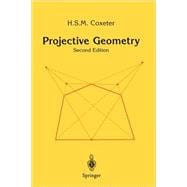
| Preface to the First Edition | v | ||||
| Preface to the Second Edition | vii | ||||
| CHAPTER 1 Introduction | |||||
|
1 | (1) | |||
|
2 | (3) | |||
|
5 | (1) | |||
|
6 | (2) | |||
|
8 | (2) | |||
|
10 | (4) | |||
| CHAPTER 2 Triangles and Quadrangles | |||||
|
14 | (2) | |||
|
16 | (2) | |||
|
18 | (2) | |||
|
20 | (2) | |||
|
22 | (2) | |||
| CHAPTER 3 The Principle of Duality | |||||
|
24 | (2) | |||
|
26 | (2) | |||
|
28 | (1) | |||
|
29 | (1) | |||
|
30 | (3) | |||
| CHAPTER 4 The Fundamental Theorem and Pappus's Theorem | |||||
|
33 | (2) | |||
|
35 | (1) | |||
|
36 | (2) | |||
|
38 | (3) | |||
| CHAPTER 5 One-dimensional Projectivities | |||||
|
41 | (2) | |||
|
43 | (2) | |||
|
45 | (2) | |||
|
47 | (2) | |||
| CHAPTER 6 Two-dimensional Projectivities | |||||
|
49 | (3) | |||
|
52 | (3) | |||
|
55 | (2) | |||
|
57 | (3) | |||
| CHAPTER 7 Polarities | |||||
|
60 | (2) | |||
|
62 | (2) | |||
|
64 | (1) | |||
|
65 | (2) | |||
|
67 | (1) | |||
|
68 | (1) | |||
|
68 | (2) | |||
|
70 | (1) | |||
| CHAPTER 8 The Conic | |||||
|
71 | (4) | |||
|
75 | (1) | |||
|
76 | (2) | |||
|
78 | (2) | |||
|
80 | (1) | |||
| CHAPTER 9 The Conic, Continued | |||||
|
81 | (4) | |||
|
85 | (2) | |||
|
87 | (1) | |||
|
88 | (1) | |||
|
89 | (2) | |||
| CHAPTER 10 A Finite Projective Plane | |||||
|
91 | (1) | |||
|
92 | (3) | |||
|
95 | (1) | |||
|
96 | (1) | |||
|
97 | (1) | |||
|
98 | (4) | |||
| CHAPTER 11 Parallelism | |||||
|
102 | (1) | |||
|
103 | (2) | |||
|
105 | (1) | |||
|
106 | (1) | |||
|
107 | (1) | |||
|
108 | (1) | |||
|
109 | (2) | |||
| CHAPTER 12 Coordinates | |||||
|
111 | (1) | |||
|
112 | (4) | |||
|
116 | (3) | |||
|
119 | (3) | |||
|
122 | (2) | |||
|
124 | (2) | |||
|
126 | (3) | |||
|
129 | (3) | |||
|
132 | (1) | |||
| Answers to Exercises | 133 | (24) | |||
| References | 157 | (2) | |||
| Index | 159 |
The New copy of this book will include any supplemental materials advertised. Please check the title of the book to determine if it should include any access cards, study guides, lab manuals, CDs, etc.
The Used, Rental and eBook copies of this book are not guaranteed to include any supplemental materials. Typically, only the book itself is included. This is true even if the title states it includes any access cards, study guides, lab manuals, CDs, etc.